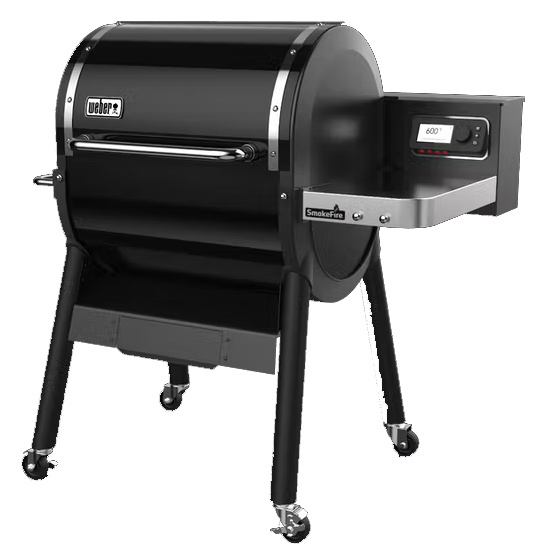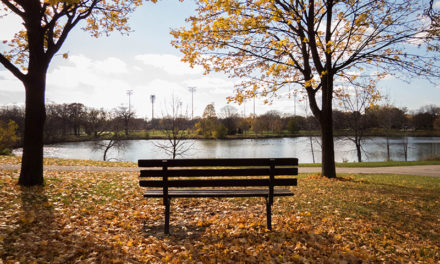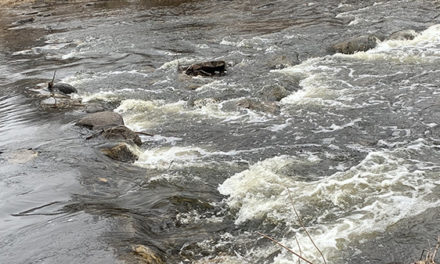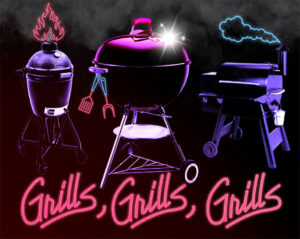 Summer means lots of things, but it definitely conjures images of outdoor cooking. Sharing brats and burgers, ribs and hot dogs, for families and friends and so much more – the grill becomes the focal point of many summer afternoons and evenings, making the best of the warmed-up weather.
Summer means lots of things, but it definitely conjures images of outdoor cooking. Sharing brats and burgers, ribs and hot dogs, for families and friends and so much more – the grill becomes the focal point of many summer afternoons and evenings, making the best of the warmed-up weather.
While charcoal/wood burning grills have been around for as long as people have been cooking, newer designs like pellet burners and Kamado eggs help to bring the art of outdoor cooking to new levels.
Whether you prefer a gas or propane grill that fires up on command or want to explore what the latest pellet grills are all about, you have many different options to consider and a world of details to evaluate when it is time personalize your BBQ.
Charcoal/Wood burning – The concept here is easy (burn stuff, cook on it) but the differences in wood/charcoal grills make a big difference in performance. You can look at grills with separate burn boxes, allowing you to use indirect heat to smoke meats for longer periods of time. You can look at small, portable grills to take on picnics or for tailgating – or opt for a larger, more permanent kettle or barrel grill that has a fixed place in the yard.
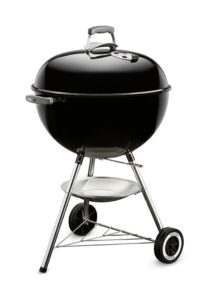 Grills that burn have different shapes that make them perfect for different situations. Deeper grills may take longer to reach ideal heat but can maintain it for longer periods of time and may offer additional cooking space. Smaller grills may be faster to heat and cool, making them smarter options for picnics, the beach, or other “portable” events.
Grills that burn have different shapes that make them perfect for different situations. Deeper grills may take longer to reach ideal heat but can maintain it for longer periods of time and may offer additional cooking space. Smaller grills may be faster to heat and cool, making them smarter options for picnics, the beach, or other “portable” events.
Kamado grills, popularized in the US by “The Big Green Egg,” provide their owners a truly unique grilling experience. Some Kamado grills are ceramic like the Big Green Egg, while other models are made of metal. The newer metal ones tend to be cheaper and weigh less, but there is no questioning the popularity of the Big Green Egg. And I even confess to having one myself!
Able to reach blistering temperatures over 600F or maintain a low, slow 220F, the Egg delivers brilliantly on items from chicken to pork, steaks, fish, or even pizza! Fans of the Big Green Egg are called “Eggheads” and have many online fan sites to swap recipes and grilling hints. They swear by it and claim no other grill can match the versatility and performance of the Big Green Egg. I tend to agree!
An Egg is very heavy and needs space when operating. Mine is on a set of wheels, making it easy to move it in and out of the area I cook in. I use hardwood charcoal and chunks of solid hickory and red oak in mine and am amazed by how tender and flavorful my finished meats are.
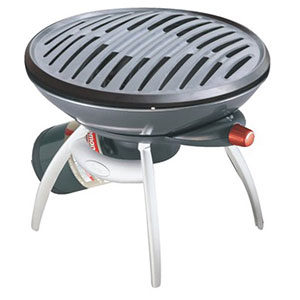 Though an Egg is very versatile, I use mine for smoking most often – I have a gas grill and another charcoal burner for other efforts. I find having multiple grill types is a blessing as a cook – I can decide whichever one I want to use for whatever challenge is in front of me.
Though an Egg is very versatile, I use mine for smoking most often – I have a gas grill and another charcoal burner for other efforts. I find having multiple grill types is a blessing as a cook – I can decide whichever one I want to use for whatever challenge is in front of me.
Know too, that today there are wonderful hybrid grills that combine different cooking methods all in one grill. You can have separate burn boxes to smoke meats low and slow or cook directly over the coals. There are a variety of shapes and sizes employed to accommodate any need, and even gas/charcoal combos that allow you to decide which one you want to use on every cook.
From price point through versatility, there’s many good reasons these types of grills remain popular for all kinds of backyard barbecues and more every summer.
Gas/Propane – Always popular with grilling enthusiasts, the gas or propane grill is efficient and easy to use in almost any situation. You might have external tanks to refill and connect, or if you are like our publisher, you avoid the tanks and connect directly into the house’s natural gas line. There is always a grill ready to go at the Haise house!
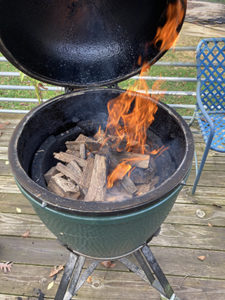 Gas/propane grills, whether on a tank or on the gas line, will fire right up and come to temperature much faster than a wood burner. They are simple to use, burn clean, and cool down quickly.
Gas/propane grills, whether on a tank or on the gas line, will fire right up and come to temperature much faster than a wood burner. They are simple to use, burn clean, and cool down quickly.
They range from the simple and inexpensive, to grills costing more than $2000, with side burners, digital temperature monitoring and other options. You can really go after a gas grill in a variety of different ways and apply almost any budget and still be able to find something great.
While gas and propane does not add the smoky flavor that you will get from cooking with wood or charcoal smoke, you can typically add wood chips or pellets to accommodate any effort in layering your flavors. Liquid smoke also comes in a bottle and can be added to marinades and grilled meats.
Gas and propane grills may need replacement parts and maintenance over time, much more than a wood burner. Usually, they are among the more expensive options for grills, though the price range always includes lower ones too. They often boast excellent extras, like side burners, thermometers, or extra grill space to help you manage larger parties. They are easy to use and super popular, for sure.
Pellet Grills – Though the technology has been in use for the last 30-40 years, the pellet burning grills have really gained popularity recently. Why? Because with digital age advancements, pellet grills are now able to connect your cooking to precisely dialed-in thermometers and timers, accessibly connected on your phone or laptops. (Pssst – there’s an app for that!)
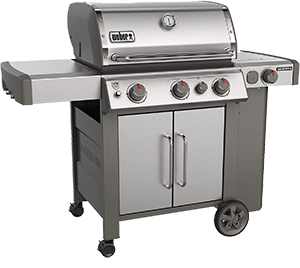 With apps and devotees to help you support every aspect of the grilling experience, pellet grills deliver finished meats that have truly unique texture and flavor profiles.
With apps and devotees to help you support every aspect of the grilling experience, pellet grills deliver finished meats that have truly unique texture and flavor profiles.
A pellet grill is electric – they plug into a standard wall outlet. There is a separate “hopper” where you load in pellets to heat the grill and infuse smoke flavor, and a standard cooking area similar to a gas or wood burner.
There is a metal grease catching tray under the grill that also makes the heat indirect and helps the heat to be super efficient and controllable within the cooking area. A chimney vents the cooking area and produces air flow.
Pellets come in a variety of hardwood flavors. They are sold in large or small bags, and are available online or at most home improvement shops. The amount you use per cooking session depends on the style and intensity of the cooking: hotter temps and longer cooks need more pellets, while simple meals don’t go through many at all. You just keep the hopper filled, and it works like a charm. A large bag of flavored pellets is about $20-40 and lasts my son multiple grilled meals.
I have seen my son and his friends really push the boundaries of what they make with their Traeger grills. It might be normally grilled meals like steaks or pork chops, but it also might be something you’d normally do in the kitchen like a pot roast, a smoked cheese dip, or even a pie. They are infusing smoke and flavorful, intentional cooking methods into everyday items, and really punching up their menus!
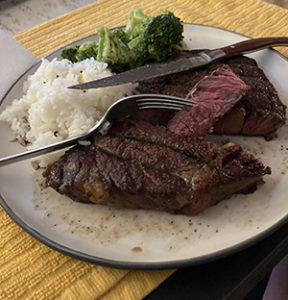 “The Reverse Sear” – My son has a Traeger pellet grill and introduced me to its Reverse Sear technique, which is unique to grilling. To sear a steak on most grills, you’ll heat to a super high temperature and then put your raw steak on it. You are using the high heat to cook it more quickly than otherwise and searing the outside edges with the grill’s high heat. The Traeger does this process in reverse – first, he cooks the steak at a lower, constant heat (225F), bringing the internal temperature to about 130F. This step (about an hour or so) gently cooks the steak with indirect heat and smoke and infuses in it the delicious wood flavor from the pellets. He then removes the meat and brings the temperature in the Traeger up to over 450F, so when he puts the steaks back in to finish, they sear beautifully with just 3 minutes per side. We let the steaks rest for 20 minutes, and the result is delicious and uniquely done – there is nothing quite like the texture of a finished steak with a reverse sear.
“The Reverse Sear” – My son has a Traeger pellet grill and introduced me to its Reverse Sear technique, which is unique to grilling. To sear a steak on most grills, you’ll heat to a super high temperature and then put your raw steak on it. You are using the high heat to cook it more quickly than otherwise and searing the outside edges with the grill’s high heat. The Traeger does this process in reverse – first, he cooks the steak at a lower, constant heat (225F), bringing the internal temperature to about 130F. This step (about an hour or so) gently cooks the steak with indirect heat and smoke and infuses in it the delicious wood flavor from the pellets. He then removes the meat and brings the temperature in the Traeger up to over 450F, so when he puts the steaks back in to finish, they sear beautifully with just 3 minutes per side. We let the steaks rest for 20 minutes, and the result is delicious and uniquely done – there is nothing quite like the texture of a finished steak with a reverse sear.
Considerations for dialing-in your perfect grill:
- What do you want to cook? Generally speaking, how many people do you anticipate regularly grilling for? Is it most often burgers and dogs, or slow-cooked ribs and pulled pork? While you may have exceptions to any plan, if you think about what kind of grilling you’ll do most often it will help to narrow and realistically focus your search. You might also need more than one grill to accomplish the things you want to do…very common to have both a gas grill for ease/speed, and a smoker for longer, slower cooking.
- Time – A gas or pellet grill heats up to task in just minutes, a charcoal or wood burner takes more time to reach proper heat, and a Kamado might need even more time to get going. A chicken breast or fish filet can cook quickly while a pork butt takes hours at lower temperatures. If time matters in the way you will cook, use it to help guide your search for the right grill. You might easily need more than one!
- Cost – Small, portable grills can be less than $50 and be carried most anywhere, while large gas, pellet, or Kamado grills can cost $2000 or more and need a more permanent spot. Gas grills range from a few hundred to thousands as well – so you can really answer the needs of any budget or intention by selecting the right grill(s).
- Taste – Gas-cooked food tastes different than charcoal, which also tastes different than wood chips or pellets. Smoke is an important consideration in grilling most items. A gas or propane grill somewhat limits this option while a charcoal or pellet grill allows you to experiment more directly with different wood smokes as additional flavor profiles. Many people have more than one grill to accomplish more than one flavor-producing technique.
- Ease – Mastering the use of any grill takes time and dedication. However, a pellet grill or Kamado requires additional knowledge of how the grill works too – and some people prefer to spend less time with cooking. It’s also super easy to start a pellet or gas/propane grill, while the charcoal or Kamados need more time and effort to get going for each cook. Also consider if you’ll need to add more fuel or adjust the grill height during the cook – will that be a chore?
- Airflow – While all grills need airflow, charcoal/wood burners and Kamados need solid builds to provide the best efficiency. Look for lids that are nice and tight and well-made vents, for the tight seal and proper venting allows your best airflows. Make sure you have air flowing around the grill for safety and for efficiency, regardless of which grill you are choosing.
- Cleanup – Gas/propane are going to be your cleanest options for sure. Pellet grills can be pretty easy to clean as well, while most charcoal and Kamado grills are messier, and clean-up is a definite consideration. Wood and charcoal smoke leaves residue, and the burnt fuel (ash) needs removal, as will grease – how easy will it be? Make sure you can keep vents, seals, and airflows clear and efficient without a lot of effort as well.
What’s the Rub?
The key to making most slow-cooked meats even more delicious comes from the dry rub. Maintaining a low heat of 250F or less for hours at a time is its own challenge but having a great dry rub can take your slow-cooked meats to the next level, and really let you personalize each meal.
Here’s a simple recipe for a dry rub that will work well with pork, chicken, or even a brisket. It is a loose recipe (more like suggestions) allowing you to eyeball all the ingredient amounts, and use whatever you have on-hand in the pantry:
- Garlic powder – note, not garlic salt, which is different. Garlic and onion powder together make a solid underlayer – use a lot of them both.
- Onion powder – there are different types of dried onions, this is probably the best for rubs.
- Salt and Pepper – coarse ground for me – and sea salt does not melt like other salt does. Be gentle with adding salt – you can’t take it out later.
- Chili powder – be careful here, this can easily add excessive heat if you’re too liberal with it. Typically, a little goes a long way with chili powder but it’s perfect in rubs.
- Paprika – I prefer smoked paprika, if you have it…it adds a nice dimension
- Crushed red pepper flakes – also something to be careful with, as you can’t take out your added heat…but a little heat is usually expected and beneficial
- Cumin – excellent dry spice, powerful character and perfect for both pork and chicken
- Brown sugar – to offset the heat, and it also adds a level of glazing to the meats – don’t go overboard, but it is a solid add to any dry rub (though I do not add it often to beef)
If you liberally mix the above, you will have a great base to start with, and really, it might be all you need to perfectly flavor your meats.
Personally, I like to add dried aromatics and herbs too, like the following (in no particular order): Basil, oregano, tarragon, rosemary, thyme, and sage. You can add different amounts of these to most anything, and it will not hurt you one bit. Combos of them, premixed by the manufacturer and called “Italian Blend” or something similar, also come in handy for creating great dry rubs.
Dry spices to add specific complexities to your efforts might include cinnamon, nutmeg and allspice (a killer trio for chicken and pork), or things like dried lemon or orange peel, ginger root, Asian five spice, star of anise, or anything else you have lurking in the spice drawer. I love to dial-in specific flavor profiles depending on what I am smoking, and what the meal will be…look for complimenting blends to layer!
Colonel Mustard did it in the Study…here’s a simple, effective hint: before you rub down your meat with your dry rub, rub it down first with plain yellow mustard. The mustard helps the dry rub adhere to the meat while adding a subtle layer of flavor and moisture – it works wonderfully, but it is rather messy! Use disposable gloves or even a plastic bag over your hand to help spread the love, and your dry rub will stay where you put it.
Grill Safety
- Keeping things safe around the grill is not too hard to do, but it is important to keep in mind.
- You will want to ensure there is sufficient space around the grill for airflow and for safety – no matter which kind you use, it will be very hot.
- Make sure your grill is on a level surface. Be aware of how much fuel to use in charcoal/wood burners, as they will have a maximum amount allowed for safety.
- Keep a fire extinguisher nearby – the ones rated as “Class ABC” are suitable for wood, grease and electrical fires – using water alone may not be a good idea for food-related fires.
- Use long handled tongs and tools to keep your hands out of the heat – opt for tight fitting sleeves and avoid wearing things that might drag through the hot zone.
- Allow the grill to cool completely before touching the outside or covering it.

